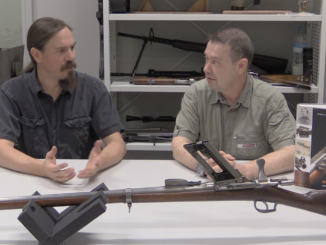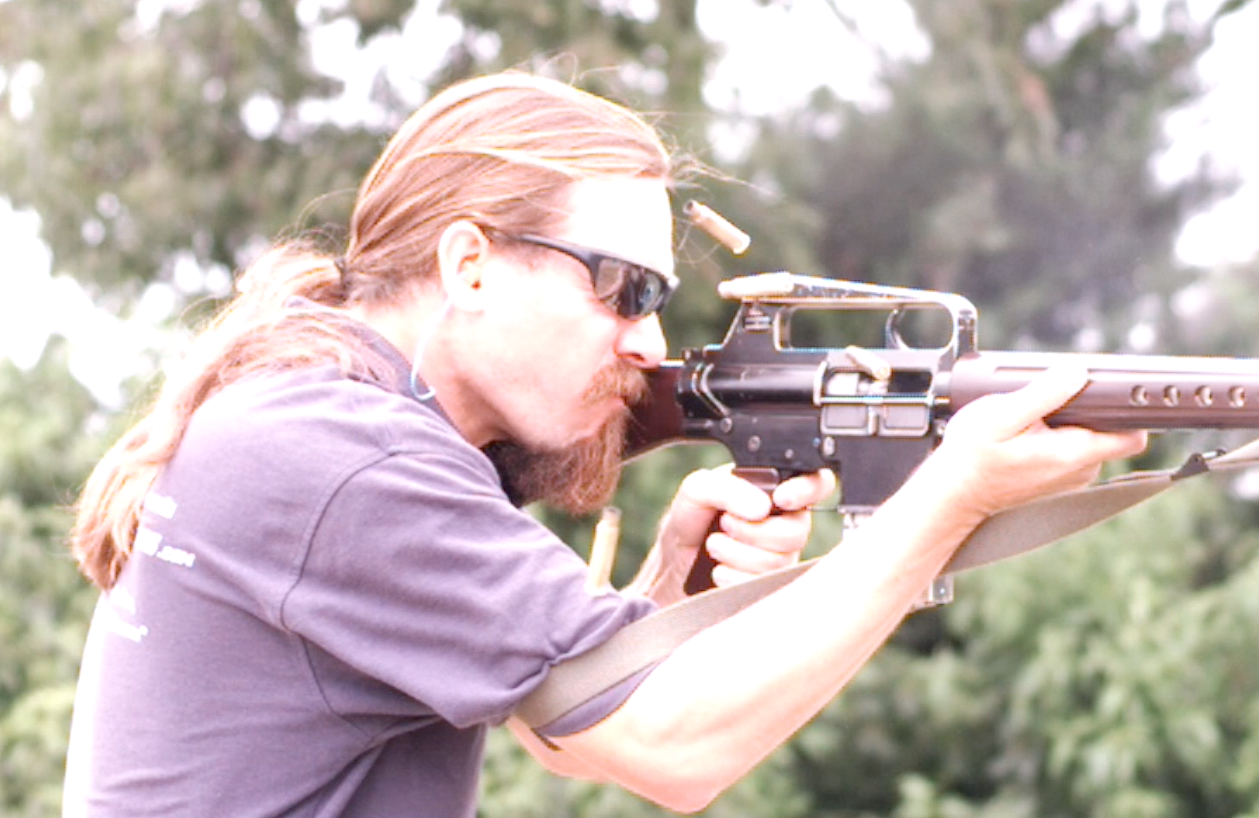Snabb was a Swedish company created to market a system for converting bolt action rifles into semiautomatic rifles. The system was patented in the US in 1938, making this one of the very last attempts at such a conversion. It appears that the company made a substantial number of overtures to many different nations in search of a customer, as Snabb conversions can be found built on a wide variety of rifles – several patterns of Mauser, the US M1917 Enfield, 1903 Springfield, and in this particular case a Dutch Mannlicher. Not surprisingly, no country was shortsighted enough to actually convert its rifles into Snabb semiautos – you will understand why when you see how the rifle works!
The basic system is a gas trap one, but complicated by the use of a two-part system of interlocking ratchet teeth so that the forward blast of gas from firing pulls the muzzle cap forward, but it is the rearward return of the muzzle cap which actually propels the bolt rearward. The bolt remains a two-lug rotating type, with the manual handle removed and a screw cam added to the rear to convert the rearward movement of the operating rod into a rotary movement to unlock the bolt.
The strange stock is necessitated by the extension of the receiver to fully enclose the bolt’s travel (not necessary with a manually operated bolt action rifle). With that extension, the trigger remains too far forward for a conventional grip, and a pistol grip is required. Snabb probably used the thumbhole style because it is stronger than a standalone grip. On this particular rifle, the original follower in the magazine is missing, but the rifle appears to have remained fed by 5-round Mannlicher clips. In addition, the rifle has been rebarreled in .303 British as part of the conversion, for unknown reasons.
Finally, it is worth pointing out that there is no “Snabb” marking anywhere on conversions like this one. They are quite distinctive and easy to recognize, but very difficult to research without knowning the name in the first place.
Thanks to the Dutch National Military Museum for allowing me access to film this rifle!




“system of interlocking ratchet teeth so that the forward blast of gas from firing pulls the muzzle cap forward, but it is the rearward return of the muzzle cap which actually propels the bolt rearward.”
This sound familiar to unfortunate St. Étienne Mle 1907 machine gun
and also bit familiar to Standard Arms Model G: https://gundigest.com/more/classic-guns/remembering-the-late-model-g
Was the design team trying to avoid patent infringement lawsuits? And just why did nobody on the team use a simple layout for the gas system? I suspect that some genius got ahead of himself and forgot the purpose of the project! Did I mess up?
“I suspect that some genius got ahead of himself and forgot the purpose of the project!”
All in all, it looks that hopefully cheaper solution finally was not so cheap.
Generally, bolt-action repeating rifles and straight-pull bolt-action repeating rifles are designed for operating by human being. Powder gases on the other hand are much more vigorous in operation, which mean that one cycle (time between igniting cartridge and fully ramming new cartridge into chamber) is short, impossible short for manual operation. Thus all rifle must be designed with more power applied to operate in mind – such complication might be used to avoid using excessive power in mind.
They were probably trying to duplicate the effect of other bolt-action-to-self-loading conversions like the British “Sword Guard” pattern or the later Charlton, or the various Swiss attempts, while avoiding having gas tubes, etc, bolted to the outside of the rifle on the right side.
Generally speaking, this sort of trick was easier with “straight-pull” bolt actions like the Swiss Schmidt-Rubin or the Austrian Mannlicher M1886. Since they either were turnbolts with a built-in cam path to rotate same (the Schmidt-Rubin). or a non-turning bolt with a moving locking block (the M1886), there was no need for an extra system to turn the bolt; only back-and-forth movement was required.
A conventional turning bolt requires an additional system to do the turning, as here. This is known as “doing it the hard way”.
cheers
eon
It was probably converted to .303 because I doubt that 6.5mm Dutch was much easier to get back then.
Back in the early ’90s some Dutch Mannlichers came in. I thought about getting one but had my doubts about the supply of ammo (and components). A wise decision to pass was made. As far as I know, even Prvi Partizan/Hanson and Fiocchi didn’t make it.
“Snabb was a Swedish company”
Photo of 6,5 mm selvladegevær “Snabb” 38 forsøk
https://digitaltmuseum.no/021025801075/gevaer?count=1309&pos=219&page=10&query=krag
It seems to be earlier or at least less advanced one – no thumb-hole stock (only pistol grip) and no bolt shroud, bolt handle was retained.
The snabb is good for one thing at least: It’d make an excellent movie prop with it’s distinctive look. Maybe one day we’ll see a science fiction or gaslight fantasy starring the Snabb conversions.
I assume your cast of characters can afford the rifle in the story. And even then, be careful not to permit any permanent modifications to the actual guns (or else their historical value is ruined). The guys who chopped the stock of a rare paratrooper rifle did not think the rifle was valuable…
The odd gas trap system provides some delay, allowing chamber pressure to drop. While straight pull actions are easier to convert, they are not known for their great extraction. The change to .303 is curious, as Othais at C&Rsenal points out in his Ross rifle video, that wartime British production ammo wasn’t manufactured to high quality standards and led to extraction problems with the Ross.
Presumably you could alter just the gas trap in attempts to get this gun to run reliably.
As Daweo correctly points out above, the poor leverage for extraction on a straight pull isn’t a problem when converted to gas operation. Despite the shortcomings of this rifle, the conversion of a turnbolt rifle into a straight pull before converting into semi auto is an innovative idea.
bloody hell! snabb management thought this was a viable weapon? The bolt extension to give it rotation looks ok though.
Any conversion a bolt-action rifle into a semi-automatic rifle will need a complete redesign of the overall layout, not a “quick-fix.” Such a redesign should include moving the trigger group away from the magazine to simplify the stock and creating a simpler gas system or one with a buffering interface. Thus, we do not convert entirely but design anew!
This does not look like Mannlicher at all. As I recall, there was one Italian conversion (Ian found it in Beretta’s depository) based on that design which was half-baked, but looked 10x better than this.
Just quick look at some Koucky designs from same period tells you this could not stand a chance.
No single conversion of repeating rifle into self-loading rifle ended with big success, despite several attempts, varying in alteration of base rifle, from just adding gas system like http://www.hungariae.com/Mann95Ru.htm to making rifle hardly recognizable as rework of earlier system.
Only somewhat successful conversion was CHARLTON but it was from rifle to light machine gun not self-loading rifle: https://en.wikipedia.org/wiki/Charlton_Automatic_Rifle
this mean additional weight was acceptable (7,3 kg for self-loading rifle is positively too much) and in term of ergonomics
As cheesy as Charlton looks, you are right. I also agree with some of your earlier memos.
Aren’t all of these conversions half baked. 🙂 The Dutch Mannlicher was a development of the German 1888 Commision rifle. The Germans may have infringed on the en bloc clip design, and Steyer obtained the rights to manufacture export guns. They refined the design and slapped Mannlicher’s name on it, which is confusing because of his well known straight pull actions.
Pertaining the .303 instead of 6.5 question: a Dutch army commission of 1910 had unanimously agreed that 6.5 mm was outdated. The commission recommended rebuilding rifles and MGs to 8 mm or something similar on account of the lack of stopping power of the 6.5 bullits. This had been demonstrated in small wars in the Netherlands East Indies (NEI), todays Indonesia. In practice Dutch (and NEI) arms procurement was opportunistic. Cheap English second-hand (Vickers) and German (08/15) shooting .303 and 8 mm Mauser respectively were added to the inventory complementing the 6.5 Mannlichers and 6.5 Lewis gun LMGs. The Hembrug Armory just had to manufacture ammo and spare parts for all of them.
I suppose that it had always been an ideal of Army procurement to unify rifle and MG ammo on a cartridge bigger than 6.5, like the .303 or the 8 mm Mauser.
IMHO the reason why the Dutch liked to buy Austrian weapons in the early 19th century rather than German, French or British weapons was political. Austria was not a direct neighbour or competitor. Buying Austrian fit well with the then Dutch strategy of neutrality.